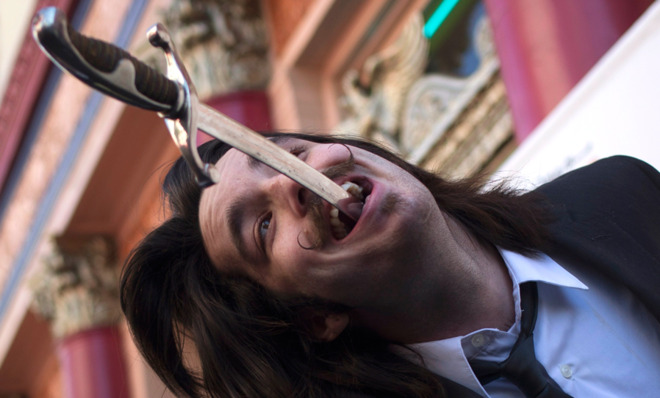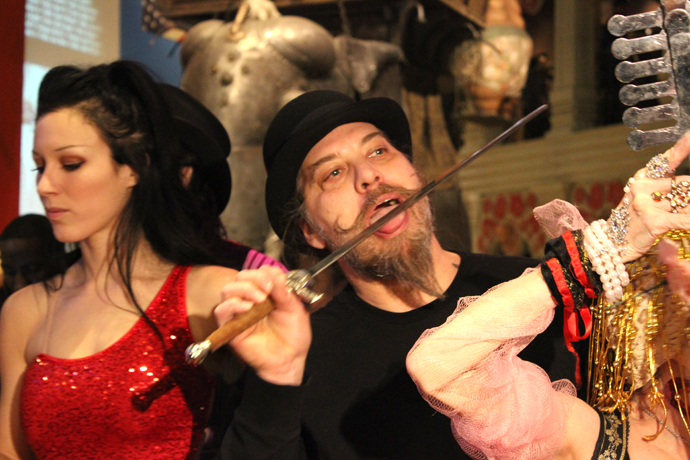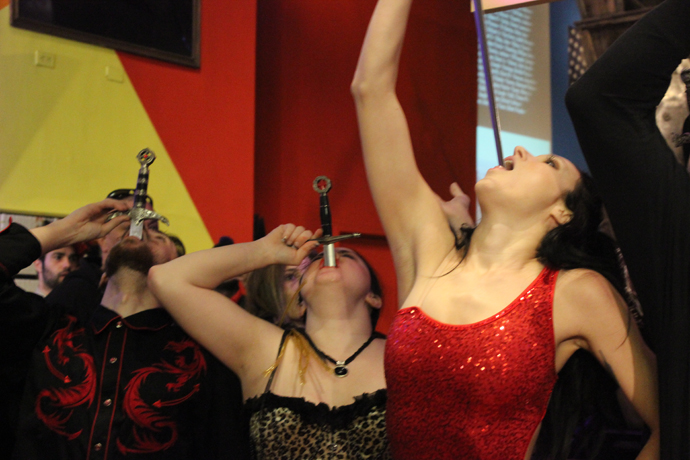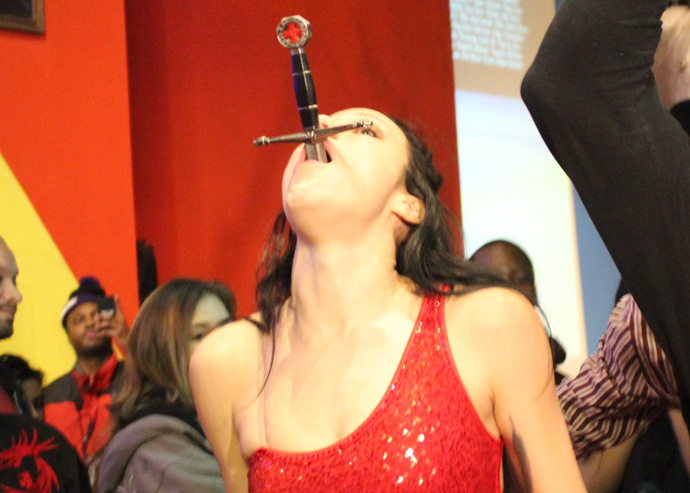How to swallow a sword
Don't try this at home

Every sword swallower I have ever met offered me the same piece of advice: "Don't do it."
And yet, there they were, nearly a dozen sword swallowers in the lobby at Ripley's Believe It or Not Times Square last Saturday, all ready to drop sword in honor of the 7th annual Sword Swallowers Day.
Some of the swallowers, like Rush Hicks, said he swallowed swords because he's a "natural born freak." Others did it out of necessity. Alicea Diaz, 22, said she was downing steel blades to pay her way through nursing school at Rutgers University. "It's good because I already know a lot about the body and the stomach," she said.
The Week
Escape your echo chamber. Get the facts behind the news, plus analysis from multiple perspectives.

Sign up for The Week's Free Newsletters
From our morning news briefing to a weekly Good News Newsletter, get the best of The Week delivered directly to your inbox.
From our morning news briefing to a weekly Good News Newsletter, get the best of The Week delivered directly to your inbox.
The celebration, which took place at exactly 2:22:14 (to coincide with the date) at Ripley's Believe it or Not locations around the country, was organized by Dan Meyer, a record-holding sword swallower and founder of the Sword Swallowers Association International. He wanted to start a day to raise awareness of sword swallowers, raise funds for swallowing disorders, and highlight the contributions sword swallowers have made to the fields of science and medicine.

Meyer, who "dropped sword" last Saturday at a Ripley's in St. Augustine, Fla., first saw sword swallowers in his youth when his father took him to the 50-cent sideshow in his hometown of Munci, Ind. In 1997, he met sword swallower George the Giant, who told him there were fewer than a dozen sword swallowers in the world. Meyer was intrigued, and asked how he could become one. "He gave me two tips," Meyer said. "He said, 'It's dangerous.' And, 'Don't do it.'"
Meyer didn't listen. He began practicing for future sword swallowing 10 to 12 times a day, every day, for four years. Then in 2001, he swallowed his first sword. "In order to swallow a sword you have to believe it in your head first," Meyer said.
Since then, Meyer has continued to push the envelope. He has swallowed as many as 21 swords at one time. He also co-authored the first scientific study of sword swallowing, in the British Medical Journal in 2006, a paper that won him an Ig Nobel Prize in 2007. The paper detailed the side effects of sword swallowing, which include sore throat, chest pain, and internal bleeding.
A free daily email with the biggest news stories of the day – and the best features from TheWeek.com
Of course, sword swallowing requires an enormous amount of physical and psychological preparation. How else are you going to navigate a sword down the long, windy path from your throat to your stomach?
To get there, you must first learn to suppress the gag reflex in the back of your throat, which sword swallowers work on for years. Then you have to flip back your epiglottis and relax several other involuntary muscles in the esophagus, which winds past major organs, including the heart. Finally, to get the sword into the stomach you have to relax the lower sphincter muscle and repress the stomach's retch reflex.

It's certainly not the safest job a person can get. But somehow, sword swallowing has been around for more than 4,000 years. It originated in India, pioneered by fakirs and shaman priests who wanted to demonstrate their power and connection to the gods. Sword swallowing then spread to Greece and Rome, and east to China and Japan. Medieval jongleurs and street performers brought the art form to Europe, but the practice died out during the dark ages. In 1893, sword swallowers performed at the World Columbian Exposition in Chicago, and the craze spread throughout the country. Since then, it has been a mainstay of traveling circuses and sideshows.
Sword swallowing has also made some notable contributions to science and medicine over the years. In 1868, Dr. Adolph Kussmaul of Germany performed the first direct esophagoscopy on a sword-swallowing circus performer, using a basic endoscope. In 2007, sword swallower Dai Andrews helped Dr. Sharon Caplan at John Hopkins University determine if techniques used in sword swallowing could also help patients suffering from severe throat trauma.
After the swallow in Times Square, I asked Diaz what was going through her mind during the 30 seconds or so that the sword was down her throat. She said: "All I kept thinking is I hope this is going to come up."

(All photos courtesy Amy Kraft)
Amy Kraft is a print and radio reporter based in New York. She reports on science and the environment for publications including Scientific American, Discover, Popular Science, Psychology Today, and Distillations, a podcast out of the Chemical Heritage Foundation. She is currently working on a book of humor essays. You can check out more of her writing on her blog Jaded Bride.
-
 Trump’s poll collapse: can he stop the slide?
Trump’s poll collapse: can he stop the slide?Talking Point President who promised to ease cost-of-living has found that US economic woes can’t be solved ‘via executive fiat’
-
 Sudoku hard: December 7, 2025
Sudoku hard: December 7, 2025The daily hard sudoku puzzle from The Week
-
 Codeword: December 7, 2025
Codeword: December 7, 2025The daily codeword puzzle from The Week